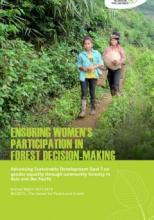/ library resources
Showing items 1 through 9 of 322.This handbook is the result of collaboration between two regional RECOFTC projects – Grassroots Capacity Building for REDD+ in Asia (REDD+ Grassroots Project) and Grassroots Equity and Enhanced Networks in the Mekong Region (GREEN Mekong Program).
The Asia-Pacific region is experiencing rapid changes. There is a major need to strengthen capacities to assist countries and forestry stakeholders to respond in ways that benefit both people and forests.
REDD+ is a proposed mechanism to make forests more valuable living and healthy than dead or damaged. Its advocates believe it could help fix a lot of persistent problems in forest management. Its opponents fear it will make these things worse.
Forestry has long been viewed as the domain of mitigation efforts. Without a doubt, the world will be hard-pressed to meet the targets of keeping the global temperature rise below 2 degrees Celsius without including the carbon-sink role played by forests.
Forests in Asia-Pacific are under threat. That's not a new story, though it becomes more important with every lost hectare and every family denied their means of survival.
Community forestry – as promoted by RECOFTC – provides an effective and cross-cutting solution that is aligned with the SDGs. This includes SDG goal 5 to achieve gender equality and empower all women and girls.
Reducing emissions from deforestation and forest degradation, as well as conservation and enhancement of forest carbon stocks and promoting sustainable management of forests in developing countries (REDD+) has been proposed as an effective mechanism to mitigate the impacts of climate change.
Read RECOFTC’s digital annual report, “Building resi
This journal article discusses the importance of empowering grassroots community to facilitate the sharing of climate change and REDD+ related information, knowledge and policies discussed at the national, regional and global level to local stakeholders.
Pagination
Land Library Search
Through our robust search engine, you can search for any item of the over 73,000 highly curated resources in the Land Library.
If you would like to find an overview of what is possible, feel free to peruse the Search Guide.









